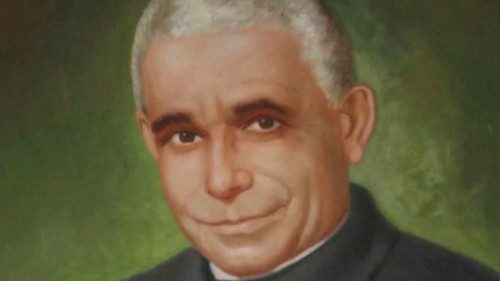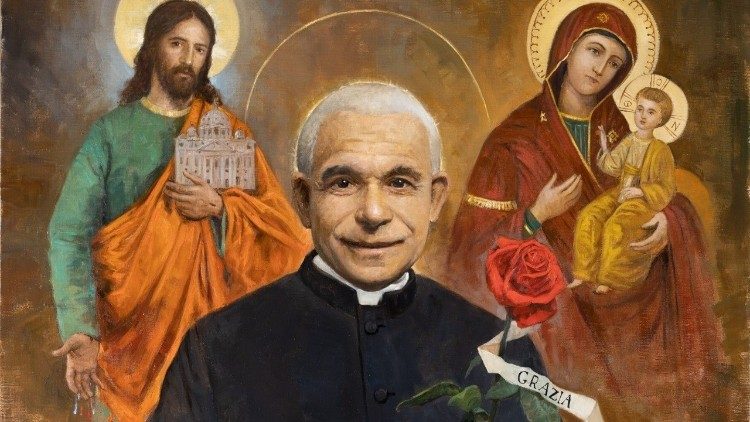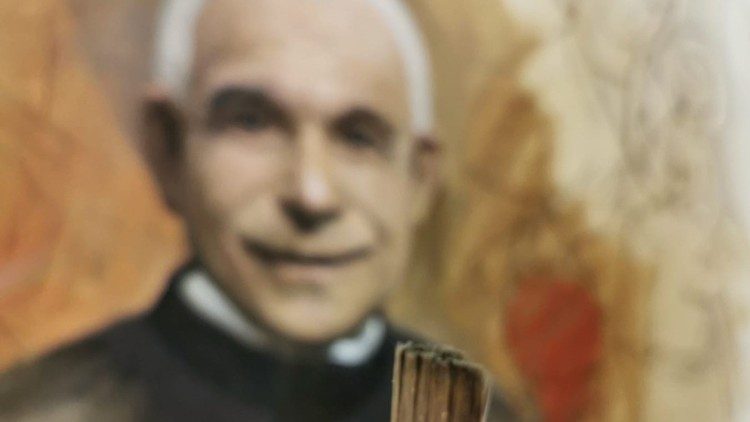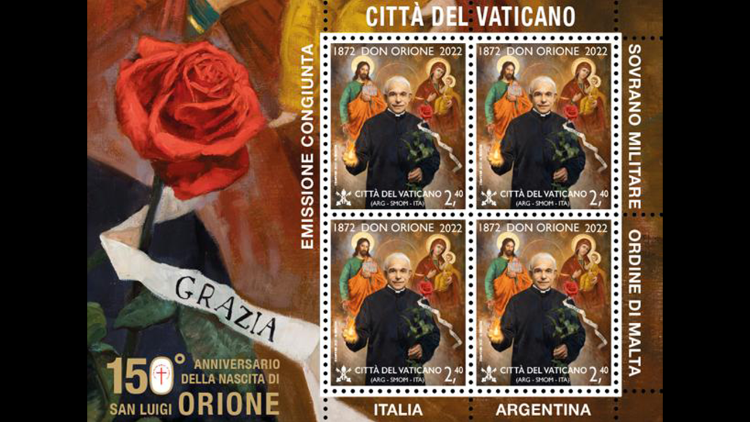To celebrate the 150th anniversary of the birth of the saint, apostle of charity and founder of the Little Work of Divine Providence, the Vatican has issued a stamp that reproduces the symbols of his birth and charism. Don Mazzitelli, Vatican Philately: “Already at the beginning of the twentieth century he saw the Church as a field hospital, open to the challenges of the world”
Alessandro Di Bussolo – Vatican City
A picture and a stamp that reproduces it are two ways chosen by the Little Work of Divine Providence and by the Vatican to celebrate the 150th anniversary of the birth of St. Louis Orione, a man of prayer and action in support of the least, who always in faithfulness to the Pope, already at the beginning of the twentieth century he saw the Church as a “field hospital, open to the challenges of the world”. In the painting, by the Spanish painter Raul Berzosa, the birth and charisma of the Tortonese saint, born on 23 June 1872 in Pontecurone, are represented through symbols.
Joint issue of the Vatican, Italy, Argentina and the Order of Malta
The stamp that reproduces it was issued by the Post and Philatelic Service of the Governorate of the Vatican City, jointly with Italy, Argentina and the Sovereign Order of Malta, on May 16, with a value of € 2.40. St. Luigi Orione is depicted with a rose on his left hand. On the same side, on the right in the image, in the background the Mother of Divine Providence and on the left Christ who holds the Vatican Basilica over his heart and with his right hand makes the tears and blood of the poor fall into the right hand of Don Orione. holy, and continue to kindle the sacred fire of charity in his work.
The sign of that rose that did not wither
The rose explains don Francesco Mazzitelli, Orionino, in charge of Philately of the Post Office and Philately Service of the Vatican City, “reminds us of the sign that the Virgin Mary wanted to give to her native country, the month before her birth: a rose brought by the mother of the future saint as a sign of devotion to the image of Our Lady of the Rosary did not wither with the passing of the days, unlike the flowers of the other commoners. The fact was reported to the parish priest who interpreted it as the sign of a special grace that Our Lady would have granted to their country ”. For this reason the artist painted a scroll around the purple flower bearing the inscription: “Grace of Mary”.
Christ brings the Church, but also the blood of the poor
The Marian image reproduced behind the Saint represents the Mother of Divine Providence, main patroness of the Congregation he founded. In this composition, Don Mazzitelli underlines, “the mystical experience of which Don Orione wrote during the International Eucharistic Congress held in Buenos Aires in 1934 takes shape and in which he recognized the synthesis of the mission that God had entrusted to him, that is the absolute fidelity to the Pope and special love for the poor: ‘I see Christ coming carrying the Church on his heart and on his right hand the tears and blood of the poor’ “.
Don Mazzitelli: in charity, hearts vibrate with the Pope
An episode that, he still clarifies Don Francesco Mazzitelli, the head of the Vatican Philately, “reminds us that the Orionine spirituality is a spirituality overflowing with love, which flows from the Trinity and pours into the heart of man, making him capable of loving”.
As Poste Vaticane you have reproduced in the postage stamp dedicated to St. Louis Orione a painting made especially for this anniversary, which is so important and which condenses all the Orionine spirituality …
Yes, in the painting we wanted to represent the anniversary first and then recall the birth of Don Orione through the symbol of the rose that bears the scroll on which “Grace of Mary” is written. This reminds us that the month before the saint was born his mother, with all the commoners of the town of Pontecurone, was doing the practical way of the month of May, so she went to recite the rosary in front of a shrine of the Madonna and how it was customary they brought flowers. One day the Saint’s mother brought a rose and they realized that this flower did not wither, despite the passing of the days. Then they went to the parish priest and asked him what this sign meant, and the parish priest replied: “It means that Our Lady is about to give a special grace to our country”. This is on the right side of the beholder: there is precisely the rose with the cartouche and the image of the Madonna. On the left side there is the image of Christ carrying St. Peter’s Basilica on his heart and with his right hand he makes the tears and blood of the poor flow into the hand of Don Orione. This image takes up a spiritual intuition that Don Orione had during the Eucharistic Congress in Buenos Aires in 1934. During this event, Don Orione says: “I see Christ coming carrying the Church on his heart and in his right hand the tears and blood of the poor” . This vision has always been considered the synthesis of the charism of our congregation, which can be summed up in two words: Pope and poor. Fidelity to the Pope, to the Church and then special love for the poor because Don Orione says that the “Establish omnia in Christo “ which is the motto of our congregation, it is realized starting from the poor, evangelizing the poor. Through the evangelization of the poor, with works of charity, the unity of the Church is recomposed and the hearts of the people are made to vibrate around the heart of the Pope.
In short, your founder was a man of action, because he went to get his hands dirty with suffering reality, but also a man of spirituality, a great mystic …
Yes, especially because he was a man of prayer, visions are not that important. In his resolutions which he made at the age of 35 he wrote: “Prayer 24 hours a day”, because not only did he spend moments of prayer, but all his activity was prayer and therefore he knew how to recognize the face of Christ in the poor. So much so that he once wrote: “Even in the poorest of men the image of God shines.”
That of your congregation has always been an outgoing pastoral care Pope Francis would now say, throwing himself “into the fire of the new times”, as your founder asked you. What does this mean in today’s times?
In the meantime, we must always go back to Don Orione because he had a perception of the Church that was prophetic for his time. He did not want to stop only at the sacramental aspect, “of the sacristy”. In fact, he made the cry of Monsignor Bandi, the bishop of Tortona, who said: “Get out of the sacristy!”. Already he, in some way, sensed what Pope Francis is telling us now, that the Church must be a field hospital, it must be open and welcoming, open to the challenges of the world, and that it cannot be built on its principles. Then Don Orione had this: on what could not be renounced, which could not be haggled, the substance should not be discussed. But then for the rest you could also share people’s lives.
You have printed 44,000 miniature sheets, equivalent to 176,000 stamps. How has the diffusion gone so far?
From what the postal operators say, it went well because it is almost sold out. This means that Don Orione’s message is still valid today, because many have taken it not only because it is a philatelic issue, but also because of the ties they had with the saint.
Also because in the leaflet you have put the rose and the word “Grace” in the foreground …
Because he has always recognized that his life was a grace of Mary. One of those women who took part in the rosary when he was about to be born met him about twenty years later and she herself said that she recognized in him the grace that Our Lady had done to the town of Pontecurone. And then he himself defined his life as one of those mountain chapels in which upon entering one sees nothing but hearts on which it says “Grace of Mary”. He also said the same thing about the congregation.
Don Orione and the rose, with Mary, Christ and the fire of charity for the poor – Vatican News




